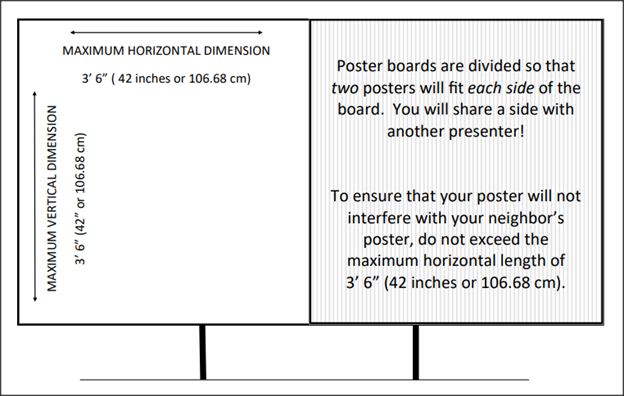Each presentation should include an introduction to the topic, key points about the topic, and a summary of the results or key points. Do not try to present details at length on a poster; instead, be prepared to discuss the details with your viewers.
Your poster should be self-explanatory. This is helpful for people who view it when you are not there, and it frees you when you are there to supplement and discuss particular points raised by an inquiry. The poster session offers a more intimate forum for discussion than a lecture presentation, but this becomes more difficult if you are obligated to devote most of your time to merely explaining your poster to a succession of viewers. You can expect some viewers to request further details about your work. Consider bringing reprints of your proposal to accommodate these requests; otherwise, be prepared to accept requests from viewers to mail information to them. You may wish to bring business cards for exchange with these interested viewers.
You may also find it useful to have on hand a writing tablet, sketch paper, or suitable drawing materials and a clipboard to elaborate on your presentation. This will also enable you to collect the names and addresses of viewers wanting details.
Materials
Poster text may be printed directly onto white paper or on thin, lightweight colored poster paper or cardboard. A lightweight paper or fabric background may be used to give text on white paper visual appeal and contrast. Do not use heavy board or foam-core, as these materials may be difficult to keep in position on the corkboard; push pins can support only modest weight and thicknesses.
Type, Size, Graphics
Your poster will be viewed from a distance (3' or more). Your Title and Author section should be in lettering no less than 1 inch high. All other letterings should be at least 3/8-inch high. Charts, drawings, and illustrations should be similar to those used in making slides (simple, heavily drawn). Use a heavy, legible font that is free from unnecessary ornamentation (such as Helvetica or Helvetica Bold). Landscape formatting of pages can increase line length, thereby enhancing readability.
Here's something called the "Toe Test": Have an associate or two stand with your poster materials on the floor next to their feet adjacent to a tipped-over trash can. Can they read it? If not, have them toe the materials into the can. Try again!
Illustrations, Photographs, Drawings
Omit unnecessary detail and ornate, gratuitous graphics. Tables of raw data are NOT as informative or appealing as graphs, and the numbers are not remembered when your viewers walk away; save such archival information for handouts. Provide each figure with a legend stating a clear, concise message in large type, at least 3/8-inch high. If necessary, detailed information can be provided in smaller type below. Because there may be little or no text accompanying your poster, the legend should contain commentary that would normally appear in the body of a manuscript. It should describe the content of the figure and the conclusions derived. Details of the methodology should be brief and placed at the end of the legend.
Arrangement, Content
Posterboards will be shared with two posters appearing on EACH side. See the diagram:

We are planning to have corkboards with a surface area of approximately 42 inches (about 106 centimeters) high and 42 inches (about 106 cm) wide. The upper left corner of the corkboard will have your Poster ID number. Please do not remove the number ID card.
The title and author(s) (with at least 1-inch-high lettering) should be centered at the top of your corkboard. Consistency in this will make it easier for viewers to scan and browse. In addition, you should include (in smaller type, but, again, no smaller than 3/8 inch) the authors' affiliation(s), including an address to which people who are unable to contact you at the meeting can write for further information. If there are multiple authors, indicate the author(s) presenting the material at the meeting.
In general, lay out your poster so that the information flows down in columns, rather than across in rows. (Imagine your viewer walking back and forth across your poster, reading it in rows like some kind of typewriter!) Your introduction should be placed at the upper left and your conclusion at the lower right (remember, 3/8-inch-high lettering). Number each part of the poster (the poster tiles) so that the vertical flow of information will be clear to all (as well as providing you with a way to check that you placed the tiles in their proper locations). Adding arrows to the tiles also helps to indicate this flow.
NOTE: High-contrast, large, clear text with appropriate graphics will draw attendees to your poster. Small type, excessive text, and poor contrast or overuse of color will cause attendees to keep walking!
Instructions for the Day of Your Presentation
Setup and Takedown
At least 15 minutes before your poster session, locate the corkboard with your Poster ID Card on it and mount your materials. Please provide your own push pins, and don't use tape. Please remove your materials promptly at the conclusion of your session. Make sure that you clean out your poster area. We do not have the staff to prepare the poster areas for the next presenters, and we cannot be responsible for materials left behind.
Reminder
Things to bring:
- Poster pieces (individual sections or one single sheet poster)
- Duplicate copy of the poster (just in case)
- Paper and pen for recording notes
- Handouts
- Business cards
- Envelope to pin to board for attendees to drop in their business cards